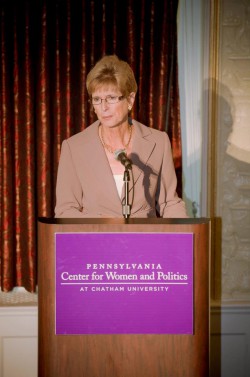Pittsburghers celebrate Rachel Carson, famed scientist who changed lives and how we look at the environment, as one of our own. Honors don’t get much bigger than having a prime bridge downtown named after you: Carson, along with Clemente and Warhol, make up our iconic Three Sisters bridges. There’s also a 35.7 mile Rachel Carson nature trail, and the Pennsylvania even named a state office building after her to house environmental protection and conservation departments.
Carson was born on a small farm in nearby Springdale. She was raised in the area and graduated from Chatham University with a degree in biology (known as the Pennsylvania College for Women at the time). But Southwest Pennsylvania actually shares Rachel Carson with the suburbs of Washington D.C. It was at Carson’s home in Colesville, Maryland that she wrote “Silent Spring,” the 1962 book that documented the health dangers of using pesticides.
In true Rachel Carson fashion, Dr. Diana Post and Cliff Hall were outside the Colesville home, making a pollinator garden during my visit in May. It’s to combat the decline of honeybees. More than 40 percent of bees in managed colonies died last year. Scientists aren’t sure why exactly, but insecticides are prime suspect.
“We’re trying to give them more habitat, more special native plants. These are all plants bees could use for their pollen collection,” said Dr. Post, a retired veterinarian.
Silent Spring advanced environmental justice at a time when the powers that be assumed they could master nature. Carson focused on DDT, a chemical used to kill insects like mosquitos. It was supposed to be a solution for insects ravaging farms. It was sprayed in the suburbs as a way to prevent Typhus, which was spread by lice.

Dr. Diana Post standing where Rachel Carson had her desk. Post holds a framed picture of Carson sitting in the space more than 50 years ago. The hope is to make the picture a reality and restore this portion of Carson’s office to the way she had it.
DDT boosters downplayed, or ignored, its unintended consequences before Rachel Carson published her research. She started collecting evidence that DDT was deadly to wildlife. One detail stood out above the rest in her investigation: Birds at a Massachusetts sanctuary were dropping dead after being sprayed with DDT. Carson envisioned a global dystopia, a spring silent of songbirds.
Dr. Post, a veterinarian by training, is no stranger to chemical’s ill effects on animals. She became concerned about the weed killer known as 2,4-D and its harmful effects on dogs. She linked up with the Rachel Carson Council, an organization for like-minded individuals founded in 1965. Post eventually became executive director, then president from 1992-2013.
In 1991 Carson’s Colesville, Maryland (11701 Berwick Rd.) home was christened a National Historic Landmark by the U.S. Department of the Interior. Dr. Post and Hall, who have been married for 30 years, acquired it in the late 1990’s. They founded the Rachel Carson Landmark Alliance, an organization devoted to caring for the home. Their goal is to maintain the sense serenity and wonder Carson had when she lived there from 1957 until her death in 1964.
“Many people who find out about Rachel Carson become inspired to carry on her work. Young people, college kids, even older people,” said Dr. Post, explaining why it’s important to maintain Carson’s spirit more than 50 years later.
Carson herself wrote of the fondness she had of her home in a letter to a friend: “It contributes to serenity. I do love it and everything I can find time to do inside or out gives me real satisfaction.”
Where the house and property are rich in Carson’s spirit, this is not a typical landmark. There are no signs directing drivers to the place, there is no parking lot, and no gift shop with Rachel Carson memorabilia. Other than a plaque above a side door, it’s just another house in an ordinary cul-de-sac community. In fact, up until 2002, Post and Hall acted as landlords and rented the home to families.
Then, in 2002, the two got a zoning exception to put a functioning office in the house and moved the Rachel Carson Council there. But, they were extremely careful not to disturb the neighbors.
“It took a lot of work,” said post about getting the exemption. “We didn’t want to alienate our neighbors with the slightest grounds. They could have objected to anything, like having extra cars parked outside. We had to be very careful.”
Being a National Historic Landmark obliges the owners to host an open house once a year to the public, and that’s about it.
“If you own a property as a private individual, it’s like a precious burden,” said Dr. Post. “It’s your fun thing, and if you get a kick out of it, great, enjoy yourself. And Cliff and I do. We love immersing ourselves in stuff about Rachel Carson.”
They get around 300 visitors a year. Some come for the annual open house, which typically happens in May (near Carson’s birthday) or occasionally school groups come for field trips. They have ambitions to make restorations to the interior of the house and restore it to what it look liked in Carson’s day.
“She sat in front of this window, “ said Dr. Post describing the window, which faces an area of expansive growth. “That area was designated by Rachel Carson to stay wet under foot for the birds and the frogs. Every owner since then has kept it wild.”
While the nation’s nearby capital overflows with monuments large and small, Carson’s house is an overlooked gem. Pittsburghers who find themselves in the D.C.-area should put it on their list of places to see.
Dr. Post welcomes visitors, and would like to see more: “Anybody wants to come are encouraged to. All they have to do is call or email.”






